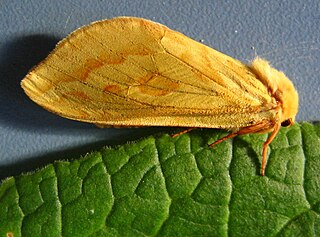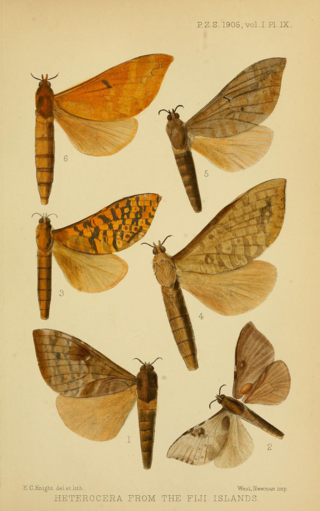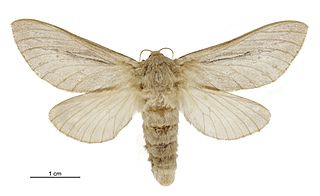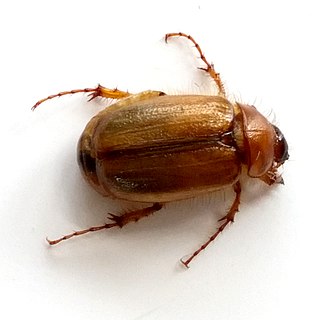
The Hepialidae are a family of insects in the lepidopteran order. Moths of this family are often referred to as swift moths or ghost moths.

The ghost moth or ghost swift is a moth of the family Hepialidae. It is common throughout Europe, except for the far south-east.

The common swift is a moth of the family Hepialidae. It was previously placed in the genus Hepialus. It is a common, often abundant European species. The species was described by Carl Linnaeus in his 1758 10th edition of Systema Naturae.

Aoraia is a genus of moths of the family Hepialidae. There are 13 described species, all endemic to New Zealand. The type species of this genus is Porina dinodes Meyrick, 1890. This genus contains some large species with a wingspan of up to 150 mm (5.9 in).

Eudalaca is a genus of moths of the family Hepialidae. There are 35 described species, most restricted to South Africa but a few found further north in the continent.

Heloxycanus patricki, also known as the sphagnum porina moth, is a species of moth of the family Hepialidae, the ghost moths. It is the only member of the genus Heloxycanus. This species is endemic to New Zealand. It has been classified as having the status of "At Risk, Declining" by the Department of Conservation.

Phassodes is a moth genus of the family Hepialidae. As of 2018, it is monospecific, consisting of the sole species Phassodes vitiensis; this species is very variable. It is found in Fiji and Samoa. The life cycle is unknown but the larva is presumed to feed underground on the roots of plants or decaying matter.

The genus Crambus includes around 155 species of moths in the family Crambidae, distributed globally. The adult stages are called crambid snout moths, while the larvae of Crambus and the related genus Herpetogramma are the sod webworms, which can damage grasses.

Ichneutica mutans, commonly known as the New Zealand cutworm or the grey-brown cutworm, is a moth of the family Noctuidae. This moth endemic to New Zealand and can be found throughout New Zealand, including from Three Kings Islands down to Stewart Island. However this species is not found in the Chatham Islands. The adult moths are on the wing all year round. I. mutans is variable in appearance and can be confused with similar species in the same genus. As a result of the variety of host species consumed by the larvae of the species, including such crops as turnips, wheat and apples, this species is regarded as an agricultural pest. However between the early 1960s and late 1980s the population of I. mutans was shown to have decreased significantly, by over 80%, at two study sites.

Dumbletonius unimaculatus, also known as the forest ghost moth, is a species of moth of the family Hepialidae. It is endemic to New Zealand. This species is host to the vegetable caterpillar fungus Ophiocordyceps robertsii.

Xyloryctidae is a family of moths contained within the superfamily Gelechioidea described by Edward Meyrick in 1890. Most genera are found in the Indo-Australian region. While many of these moths are tiny, some members of the family grow to a wingspan of up to 66 mm, making them giants among the micromoths.

Wiseana cervinata, a porina moth, is a species of moth belonging to the family Hepialidae. It was described by Francis Walker in 1865 and is endemic to New Zealand.

Wiseana copularis is a species of moth belonging to the family Hepialidae. It is endemic to New Zealand. This moth is one of several very similar looking species within the genus Wiseana and this group are collectively referred to as "Porina" moths. In its larvae form this species consumes pasture grasses and, if numerous, is regarded as a pest by New Zealand farmers reliant on good quality pasture for their stock.

Wiseana jocosa is a species of moth belonging to the family Hepialidae. It was described by Edward Meyrick in 1912 and is endemic to New Zealand.

Wiseana signata is a species of moth belonging to the family Hepialidae. It was described by Francis Walker in 1856 and is endemic to New Zealand.

Wiseana umbraculata, also known as the bog porina, is a species of moth belonging to the family Hepialidae. There are seven endemic species and three haplotypes of Wiseana in New Zealand including bog porina. It was regarded as being common in Whanganui in the early twentieth century.

Eudonia sabulosella is a species of moth in the family Crambidae. This species is endemic to New Zealand and is regarded as being common. The larvae of this species are known to damage pasture in New Zealand.

Costelytra giveni, commonly known as New Zealand grass grub, is a scarab beetle that is endemic to New Zealand and is a prevalent pasture pest.

Tingena is a genus of the concealer moth family (Oecophoridae). This genus is endemic to New Zealand.
Yersinia entomophaga is a species of bacteria that was originally isolated from the diseased larvae of the New Zealand grass grub, Costelytra zealandica. The type strain is MH96. It is currently being studied for biological pest control of insect pests like the porina moth, Wiseana cervinata.



















